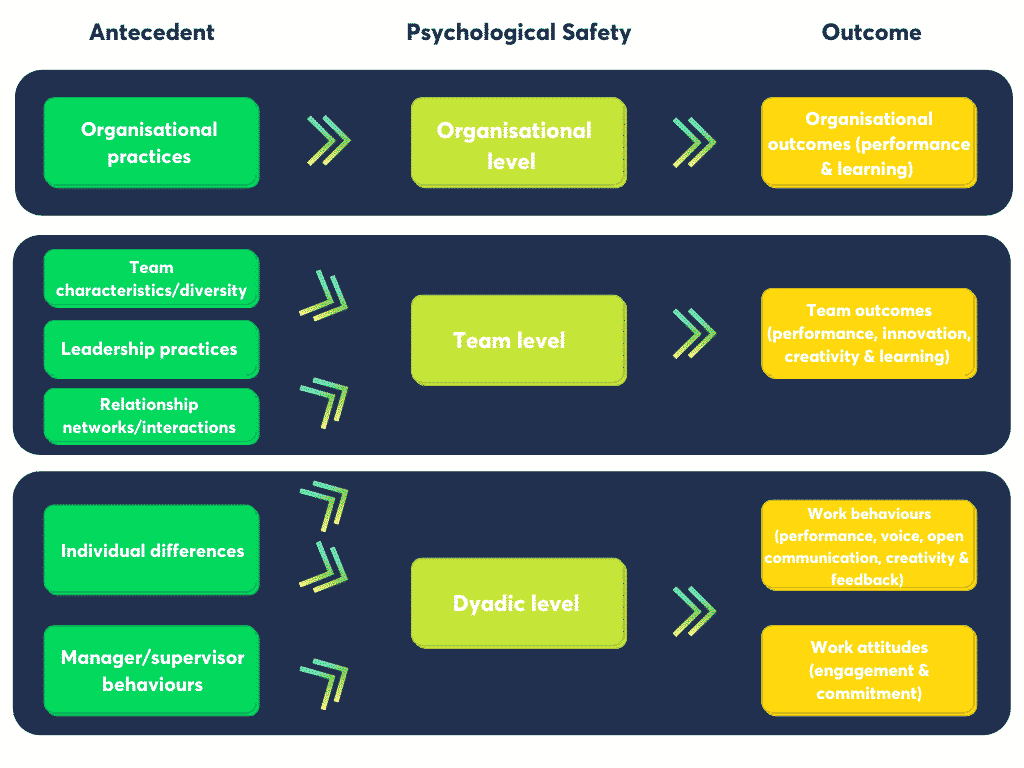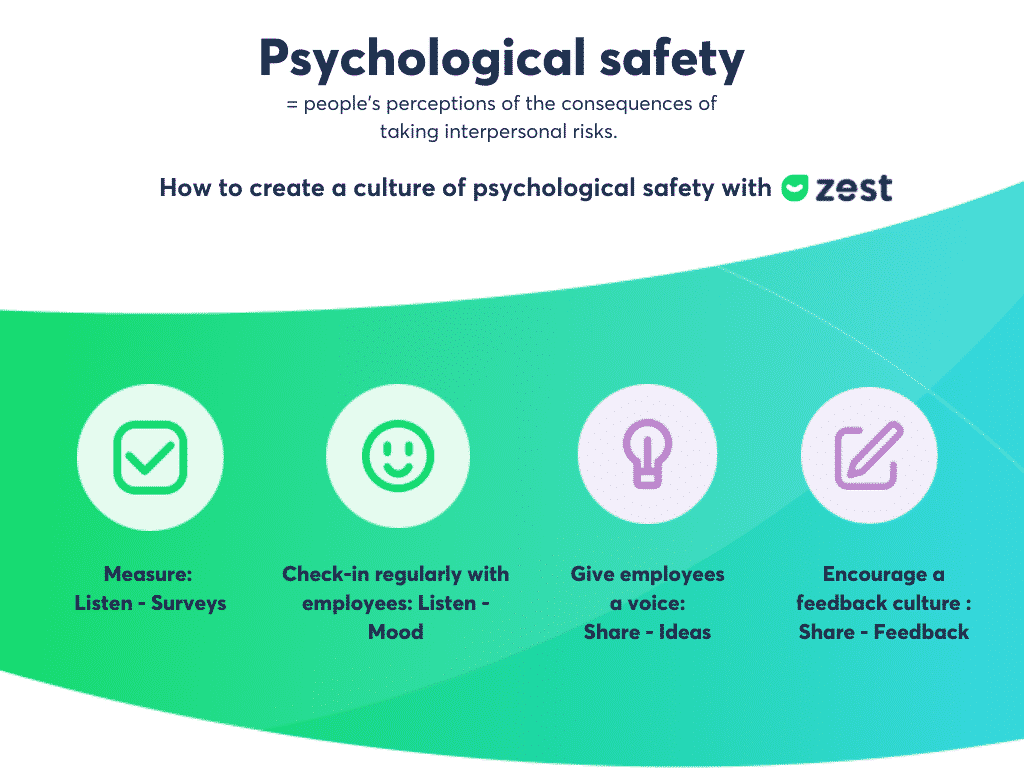Breaking news :
ZestMeUp has raised €6 million to become the European leader in employee engagement and performance 🚀
Psychological safety: the key to boosting the effectiveness of your teams & organisation |
What exactly does psychological safety look like in an organisation? What drives it? What exactly are the benefits for the organisation? And finally, how can Zest help your organisation to create a climate of psychological safety?
Challenging the status quo, suggesting new ideas or bringing up tough issues and problems in the workplace is not as simple as it seems. Such behaviours are risky for individuals. What happens if that idea you proposed doesn’t work out? Will you be seen as responsible for making that mistake? As workplace practices change and organisations increasingly look to their employees to voice their opinions and ideas, fostering an environment in which employees feel able to express themselves freely is crucial. Such a climate of “psychological safety” (a term coined by Edmondson, 1999 1) in turn has a variety of organisational benefits.
Psychological safety refers to a work environment in which:
We can consider psychological safety to exist at multiple levels: the organisational level, team level and within dyadic relationships (e.g. between an employee and their manager, see Figure 1). To measure this concept, Edmondson’s (1999 1) 7-item Psychological Safety Scale is by far the most popular, focusing on the team level. For example:
To what extent to you agree or disagree with this statement:
“If I make a mistake in this team, it is held against me.”
Nevertheless, psychological safety can also be measured at the organisational level by, for example, replacing the referent team with organisation in the above statement. Individually held perceptions of psychological safety can be examined with regards to dyadic relationships (e.g. between the employee and the manager). For example :
To what extent to you agree or disagree with this statement:
“If I make a mistake, my manager holds it against me.”
Figure 1.

A climate of psychological safety has been proven to produce a variety of positive outcomes, both for teams and for the organisation as a whole. Here are some examples:
For a full review on the many outcomes at the multiple levels, see Newman et al., (2017) 7.
Psychological safety is also essential for the success of Diversity & Inclusion (D&I) initiatives. By definition, a psychologically safe work climate is one in which people are able to speak freely without fear of negative consequences and are accepted for who they are as individuals. Studies highlight how, in order to reap the benefits of a diverse workforce (particularly regarding elevated rates of performance), a climate of psychological safety is crucial. In this sense, it can be considered a mediator in the relationship between diversity and employee performance 10.
In order to understand how to boost psychological safety within an organisation, we must first understand what drives it (see Figure 1). Just as we looked at how psychological safety exists at different levels, we can consider the drivers to also be present at all the aforementioned levels.
At the organisational level:
… drive a climate of psychological safety within an organisation 7.
At the team level:
… help to create a psychologically safe climate.
At the dyadic level:
… also influences levels of psychological safety 11.
Of course, individual differences, notably self-consciousness, inevitably play a role, such that self-consciousness is negatively correlated with perceived psychological safety 8.
So what, concretely, can be done to help your organisation to facilitate a climate of psychological safety? Here’s a few ideas:

As organisations seek to gain the competitive edge in their industry, eliciting fresh and innovative ideas from the workforce is essential. Despite being a relatively new concept, research clearly shows that fostering an environment of psychological safety is the key. As outlined above, Zest offers a simple and effective solution to help your organisation to develop this climate and subsequently boost the performance, engagement, creativity (and much more) of your teams and company as a whole!
1 Edmondson, A. (1999). Psychological safety and learning behavior in work teams. Administrative science quarterly, 44(2), 350-383
2 Google (2012). Project Aristotle. https://rework.withgoogle.com/print/guides/5721312655835136/
3 Liu, S., Hu, J., Li, Y., Wang, Z., & Lin, X. (2014). Examining the cross-level relationship between shared leadership and learning in teams: Evidence from China. The leadership quarterly, 25(2), 282-295.
4 Carmeli, A., Reiter-Palmon, R., & Ziv, E. (2010). Inclusive leadership and employee involvement in creative tasks in the workplace: The mediating role of psychological safety. Creativity Research Journal, 22(3), 250-260.
5 Wilkens, R., & London, M. (2006). Relationships between climate, process, and performance in continuous quality improvement groups. Journal of Vocational Behavior, 69(3), 510-523.
6 Bienefeld, N., & Grote, G. (2014). Speaking up in ad hoc multiteam systems: Individual-level effects of psychological safety, status, and leadership within and across teams. European journal of work and organizational psychology, 23(6), 930-945.
7 Newman, A., Donohue, R., & Eva, N. (2017). Psychological safety: A systematic review of the literature. Human Resource Management Review, 27(3), 521-535.
8 May, D. R., Gilson, R. L., & Harter, L. M. (2004). The psychological conditions of meaningfulness, safety and availability and the engagement of the human spirit at work. Journal of occupational and organizational psychology, 77(1), 11-37.
9 Chen, C., Liao, J., & Wen, P. (2014). Why does formal mentoring matter? The mediating role of psychological safety and the moderating role of power distance orientation in the Chinese context. The International Journal of Human Resource Management, 25(8), 1112-1130.
10 Singh, B., Winkel, D. E., & Selvarajan, T. T. (2013). Managing diversity at work: Does psychological safety hold the key to racial differences in employee performance?. Journal of Occupational and Organizational Psychology, 86(2), 242-263.
11 Palanski, M. E., & Vogelgesang, G. R. (2011). Virtuous creativity: The effects of leader behavioural integrity on follower creative thinking and risk taking. Canadian Journal of Administrative Sciences/Revue Canadienne des Sciences de l’Administration, 28(3), 259-269.





